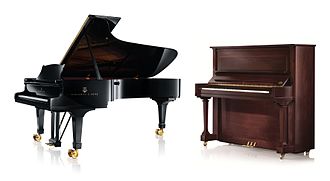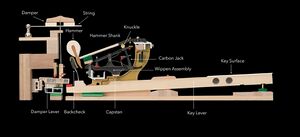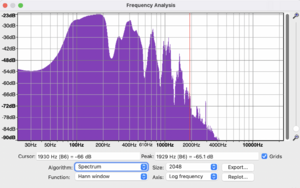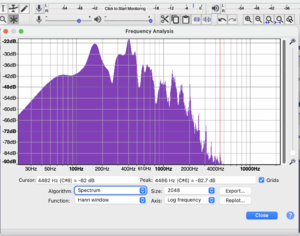Course:PHYS341/2022/Project2 Piano

By: Ko Long Yu
The piano is a keyboard and stringed percussion instrument where the strings inside the instrument are struck by wooden hammers.[1] It is played with a keyboard, where the player uses their fingers to strike the keys, allowing the hammers to hit the stretched strings to project sound. [2]
History

The invention of the piano is generally credited to Italian instrument-maker Bartolomeo Cristofori in the 1700s. [3] Cristofori, who was an accmplished harpsichord maker, had the general knowledge for the construction of the piano. The harpsichord is an instrument with a similar keyboard as the piano, but the strings are plucked instead struck, resulting in a more guitar-like sound.

The fortepiano is an early piano that is a general term for pianos by Cristofori from the 1700s to the 1800s. The most prominent addition to the fortepiano was the introduction of the sustain pedal by Gottfried Silbermann. [4] This allowed the dampers on the hammers to be lifted when a key was pressed, resulting in the sound to be sustained longer even if the player's hands are off the key.
Modern piano types
Grand
In modern grand pianos, the framework of the strings faces away from the keyboard horizontally. Once the keys are pressed, gravity brings the hammers back down to its original resting position. Because grand pianos are larger, it is characterized by its longer strings that allow for a richer sound. Thicker and fatter strings allow for a more powerful sound, which is heard especially in the lower registers. Grand pianos are frequently found in churches, large living rooms, hotels, and concert halls. The length dimensions of different types of grands are: [5]
- Baby grand: 4 ft 11 in - 5 ft 6 in
- Parlor grand (living room piano): 5 ft 9 in - 6 ft 1 in
- Concert grand (the one you would find at Chan Centre): 9 ft
Upright
As opposed to grands, upright pianos take on a more compact shape in length since the strings are vertical to the keyboard. It became ideal for players living in smaller homes or for those looking for a practice piano, making it a more accessible and affordable solution than a grand piano. The height dimensions of different types of uprights: [6]
- Spinet: 36 in - 39 in
- Console: 40 in - 44 in
- Studio: 45 in - 49 in
- Upright: 50 in - 60 in
Action mechanism and notable construction parts

Cristofori's challenge was to create an instrument where the strings are struck by a hammer, but in a way that the hammer would not stay in contact with the strings.The hammer must quickly rebound off the strings after striking it and return to its original position. However, the hammer cannot bounce off its original position as it will replay the note it just struck. In summary, Cristofori needed to navigate this problem in order for a player to rapidly consecutive notes with a clear sound. This is known as the piano action mechanism, which was the foundation Cristofori used to construct his early pianos. [7] Most traditional pianos have 88 keys, so each piano would include 88 separate action parts (Figure 1).

When a piano key is depressed, the opposite end of the key lifts upward with equal force. Along with other important parts like the capstan, dampers, and multiple levers, it results in the hammer striking the key followed by an immediate release to make the string vibrate. Without this release, the hammer would stick to the strings which would partially mute the tone and create a dull "thud" sound. [8] For the purpose of this project and the sake of simplicity, the 8000+ parts of the piano must work together to create a perfectly stable sound. Even the slightest damage or change to its dimension or position can affect performance.
Soundboard
The piano, being a relatively large instrument, consists of thousands of parts, but the core of the piano, in terms of sound quality, is related to the soundboard. [9] The soundboard is a thin wooden sheet made of spruce, which is air-dried to a particular moisture level. After being cut down to its desired shape and thickness, the soundboard is air-dried to satisfy specific climate conditions, since like many instruments, temperature and climate have an influence on the piano. The soundboard works best on its vertical, long side as opposed to horizontally. Ribs, the parts that look like lines running across the board, are assembled on the bottom of the soundboard (Figure 2). Its purpose is to drive the sound vibrations in a uniform manner throughout the soundboard, which reinforces the strength of the sound travelling vertically, and not its weaker horizontal side.
Sound properties of pianos




Pattern of frequencies and amplitudes
Like most instruments and voices, the piano possesses similar characteristics in frequencies when playing different registers and volumes. C1 on the piano would result in a waveform having a smaller period due to its low frequency (Figure 3). This note was also played at around a mezzoforte volume, so it produces a relatively larger amplitude. Figure 4 depicts a Bb4, which is almost an entire four octaves higher than C1. The waveform shows a more compact, larger period from its higher frequency. This note was played at around a piano volume, so the amplitude is noticably lesser than that of C1.
Pattern of harmonics: grand vs upright
In order to explore different sound properties of pianos, it would be extremely beneficial to test a grand piano and compare it to an upright piano in order to discuss the topic of timbre and tuning.
The inharmonicity (deviations of harmonic frequencies from precise multiples of the fundamental) of a piano requires the tones to be stretched. When stretching a smaller piano's octaves, the above octaves would sound out of tune, or "narrow". However, stretching the octaves of a larger piano, like the very long concert grands, would not disrupt its harmonic balance. The note is tuned to a lower octave's sharper overtone rather than to its real tuning. [10] A comparison of the grand and the upright is shown in Figure 5 and 6:
The different spectrum graphs show the two pianos playing the lowest C (C1). Interestingly, the ensuing inharmonicity of the grand piano, along with its fatter strings, results in the its notes sounding slightly more sharp than its "correct" frequency in equal-tempered tuning. In Figure 5, the frequency of C1 did actually come out slightly sharp at around 33 Hz, compared to the 32.7 of equal-temperament. [11] However, the trade-off is clear, as it allows for these concert grands to produce a brilliant singing-like timbre, possessing cantabile style of playing.
Below are recordings of C1s and short melodies to compare and contrast the timbre of both types of pianos. Even without adding any substantial dynamics, phrasing, or expression, the melody on the grand piano (at least subjectively) possesses a considerable singing-like tone quality. The upright, on the other hand, might sound slightly more rash. ***The Yamaha upright (which is at my home and has not been tuned for a few years) may be slightly out of tune. The Yamaha grand (which I borrowed at a Tom Lee) is more in tune to equal-temperament.***
C1 on grand piano:
C1 on upright piano:
Short melody on grand piano:
Short melody on upright piano:

Pedals
Soft pedal
Piano pedals are levers pressed by the foot at the bottom of the piano that alter the sound of the notes produced (Figure 5). The soft pedal, usually found on the leftmost of the pedals, allows the player to produce a slightly softer sound with its pedal. The strings of each note of the piano have a set of 3 strings (Figure 7). When the soft pedal is pressed, the entire keyboard is shifted so that the hammer only strikes 2 of those strings, resulting in a quieter sound. The soft pedal also changes the timbre of the note a bit by creating a duller sound rather than a bright sound. Figures 8 and 9 show a comparison of the same note (played with approximately the same volume) with and without soft pedal. As seen in the spectrum graph, the overtones/higher frequencies are less pronounced with the soft pedal. Consequently, the note played with a soft pedal dies off relatively quickly in intensity compared to the note without a soft pedal. This idea of a decrease in higher overtones and intensity is essentially the same when playing notes with a quieter dynamic in piano, compared to when playing notes with a louder dynamic in forte, even when striking the exact same note.
Sustain pedal
The sustain pedal, the most frequently used pedal in piano music, operates by sustaining the dampers inside the piano by shifting them away from the strings. This results in the strings being allowed vibrate freely, producing a "sustained" sound, even when the player is no longer pressing the key.



References
- ↑ "Yamaha Musical Instrument Guide".
- ↑ "Wikipedia: Piano".
- ↑ "Vox: Who invented the piano? And why was he forgotten?".
- ↑ "Wikipedia: Piano".
- ↑ "Wikipedia: Piano".
- ↑ "Upright Piano Types and Sizes".
- ↑ Giordano, Nicolas J. (2010). "Physics of the piano". Oxford University Press. https://www.worldcat.org/title/physics-of-the-piano/oclc/869736155.
- ↑ "Kawai piano actions".
- ↑ "Making the Body (Piano)".
- ↑ "Grand piano and upright piano sounds".
- ↑ "Equal-temperament tuning frequencies".